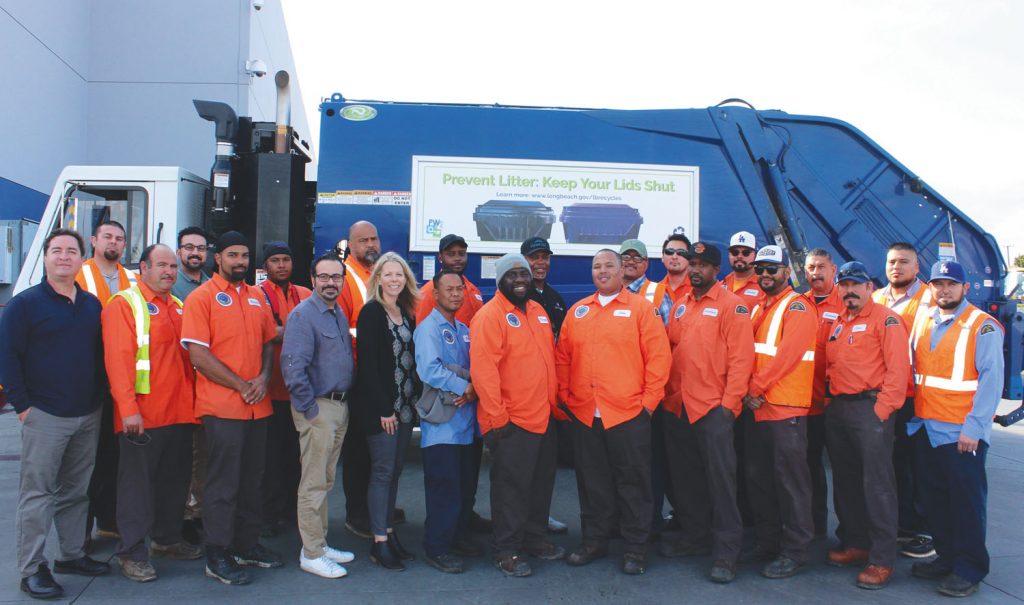
Home to the second-busiest container seaport in the United States and a population nearing half a million people, the City of Long Beach is an active zone of commerce and commuters. Major efforts have been made by city staff and local nonprofits to improve the air, water and quality of life across the city’s 50 square miles.
“It’s something that we take very seriously,” Heather Tomley, acting managing director of planning and environmental affairs at the Port of Long Beach, told the Business Journal. “We need to do our part to reduce our impacts that we’re having on the local community, the region and globally.”
Container traffic through the Port of Long Beach has grown about 20.6% over the last 14 years, from 6.71 million twenty-foot equivalent units (TEUs) of cargo in 2005 to 8.09 million TEUs in 2018, according to a port spokesperson. Such growth could have resulted in greater levels of emissions from the many vehicles that move in and out of the harbor each day – from ships and trucks to locomotives and cargo-handling equipment. Port administration has actively pursued methods of reducing the environmental impacts of these operations.
The Green Port Policy was adopted by the Long Beach Board of Harbor Commissioners in 2005 to promote sustainable technologies and practices intended to cut down or eliminate harmful pollutants. These pollutants include nitrogen oxides, which contribute to smog and ozone emissions; sulfur oxides, generated from the burning of coal and oil; and diesel particulate matter, a toxic air contaminant that has been linked to cancers and other illnesses. The port creates an annual inventory to keep track of these emissions, Tomley said. In the last 14 years, nitrogen oxides have been reduced by 48%, diesel particulates by 84% and sulfur oxides by 97%.
Tomley said that the tremendous decrease in sulfur oxides is due to a number of factors, including the reduction of sulfur content in trucks and other vehicles, more efficient engines, and a voluntary program that incentivizes vessels to slow to 12 knots as they approach the port. “By slowing down and reducing the load on the engine . . . [ships] burn less fuel and significantly reduce emissions,” Tomley explained. Vessels that participate in the program at least 90% of the time receive a dockage discount from the port. Tomley said participation in this program has been “fantastic” among vessels that call at the port, comprising 97% of all ships that approach within 20 nautical miles and about 92% of those within 40 nautical miles.
In addition to these policies, the port is also reducing the amount of diesel used in its own operations by transitioning to electric equipment. Middle Harbor, or Pier E, is almost entirely electrified – from the ship-to-shore cranes that offload equipment to the automated vehicles that move containers through the yard. “There’s only a small portion of the operations where they still use the traditional diesel equipment,” Tomley said. “The desire is to become a fully zero-emission terminal here in the future.”
The boards that govern both the Port of Long Beach and the Port of Los Angeles have called for the adoption of zero-emission vehicles and cargo-handling equipment by 2035. To help the Port of Long Beach develop this technology for commercial use, the California Energy Commission and the California Air Resources Board have donated more than $78 million in grants. Another $69 million has been raised in matching funds from other sources, including private companies.
The port has also implemented programs to improve the quality of water in the harbor district, such as regulating vessel discharges and monitoring stormwater, but Long Beach faces a major challenge in managing the pollution that flows from the Los Angeles River. To treat the bacteria, hydrocarbons, trash and pesticides that dump into the Long Beach Harbor, the city’s public works department is overseeing the Long Beach Municipal Urban Stormwater Treatment (LB MUST) Program.
Funded in part by a $1 million grant from the port, the program would involve the construction of a facility near Shoemaker Bridge on the east side of the L.A. River. “Ultimately, the goal is to try to capture the stormwater and bring it to this facility that can clean the stormwater before it enters the L.A. River,” City Engineer Alvin Papa told the Business Journal. With the facility still in its design phase, Papa said the city is hoping to begin construction early next year.
To clean the entire 12,000 acres of the L.A. River watershed would be a multi-city, $200 million undertaking, Papa estimated, so the project will progress in stages. “If you picture your body, and the veins and capillaries running through it, right now we’re just building the heart,” he said. “The entire system, that will take a long effort and a lot of people behind it continuing to push it over the years.”
In the meantime, Algalita Marine Research and Education is enlisting volunteers to remove the debris washing up on the city’s beaches. In addition to hosting regular cleanups onshore, the nonprofit has partnered with Long Beach Waterbikes at 110 N. Marina Dr. to encourage waterbike riders to clean the water, too. “The first Saturday of every month you can sign up to take them out for free,” Algalita Executive Director Katie Allen said. “We give out buckets and pool skimmers.” Kayak cleanups are held on the last Saturday of each month in Alamitos Bay.
Algalita hosts local sustainability workshops to encourage residents to rethink their consumption habits and reduce plastic waste. At its community center at 140 N. Marina Dr., Algalita sells reusable items and offers refills to replace single-use plastic bags, bottles and other containers. “We have partnered with Julie Darrell from BYO Long Beach [a local waste-reduction enterprise] and we have a full refill station for any kind of home care product you need,” Allen said. These refills include eco-friendly detergent, toothpaste, lotion, shampoo and other products. Allen said the store is extremely popular, selling over 8,000 refill items in the last 10 months.
The Long Beach Office of Sustainability has several new and ongoing projects to foster cleaner residential and commercial living. It has partnered with Southern California Edison to increase the energy efficiency of city facilities and with Mercedes-Benz USA to provide free electric vehicle chargers to the community. The office is also developing a program to install free energy-saving products and services in disadvantaged neighborhoods. “The next phase of that is to put out a request for proposals for contractors that would do the work,” Sustainability Coordinator Larry Rich told the Business Journal. Installations may begin by end of summer, Rich said.
To promote urban forestation, the California Department of Forestry and Fire Protection has given the office of sustainability a grant to plant fruit trees throughout Long Beach. Rich said that his office has enough funding to plant 400 trees over the next two and a half years. Residents were encouraged to apply for free plantings in their front yards, and demand quickly outstripped the supply. “When we launched the program, we got more than 700 applications in the first three weeks,” Rich said. Planting is set to begin this week, and fruit varieties will include oranges, lemons, limes, avocados, peaches and pomegranates.

The office of sustainability also helps local businesses to achieve “green” certification status. This program recognizes businesses throughout California that minimize their waste and carbon footprint while conserving energy and water use. More than 50 businesses have begun or completed steps to achieve this certification within Long Beach. The Blue Restaurant Certification, managed by the city’s water department, goes “hand in hand” with this program, according to Manager of Water Resources Dean Wang. This certification is targeted specifically at local restaurants that achieve water efficiency targets. “We’re hoping to roll out the blue certification to other industry sectors, such as hotels, motels, as well as maybe some other facilities in the commercial sector in the near future,” Wang said.
On the residential side, the water department has also created an incentive program to replace lawns with drought tolerant or California native plants. The Lawn-to-Garden (L2G) Program offers residents $3 per square foot of lawn removed for up to 1,500 square feet, and an additional $1,500 reimbursement for professional landscaping. “It’s been highly successful,” Wang said. “A lot of other water agencies, not only in California but across the country, have modeled their programs on the Long Beach [L2G] program.”
With 225 employees, the Long Beach Environmental Services Bureau is a robust branch of the public works department. Its duties include refuse collection, street sweeping and parking control. It also operates the Long Beach Clean Team, which removes illegally dumped items, reports graffiti, ensures property owners are keeping their store fronts up to code and cleans up homeless encampments. “We’re kind of what happens in the background of the city,” Waste Diversion and Recycling Officer Erin Rowland said. “We keep our neighborhoods clean.”
According to Environmental Services Manager and Deputy Director of Public Works Diko Melkonian, the bureau collects waste from around 123,000 accounts in Long Beach. These accounts include single-family homes and buildings with 10 units or fewer. The bureau’s street sweepers collected more than 10,300 tons of litter in 2018. “One of the most critical things that street sweeping collects, that people don’t even see, are metal particulates that come off brakes,” Melkonian explained. “All of that would go into our waterways and our oceans if we weren’t conducting street sweeping.”
The Long Beach Energy Resources Department is always looking for ways to enhance its environmental stewardship, Business Operations Manager Tony Foster told the Business Journal. “We’re well aware of the position of the city and the state to reduce the impact of fossil fuel emissions,” he said. Since 2017, his department has contracted with producers of renewable biogas for use in Long Beach Transit buses and city fleet services, such as refuse haulers and street sweepers.
Created by the decomposition of organic substances, biogas is recognized as producing net-zero emissions, Foster said. “It’s simply CO2 [carbon dioxide] that was in the atmosphere that was captured by plants, and once that biodegrades, it’s recaptured through the biogas process and re-released into the atmosphere,” he explained. By using this gas in its bussing and fleet operations, the city qualifies for renewable energy credits that cover roughly 80% of the cost of the fuel itself, he went on. “It’s a big benefit to the city to essentially get a much-reduced fuel cost that is also a net-zero carbon impact on the environment.”
Algalita’s Allen said that she has noticed a growing interest among Long Beach residents and visitors to adopt more sustainable practices. “All of our objectives relate to that concept of personal and local resiliency,” she said. “People are really starting to see it that way as opposed to, ‘Oh, I’m an environmentalist.’ We’re too intelligent to be this wasteful, and I think that is helping people change habits in a very sustainable way.”
